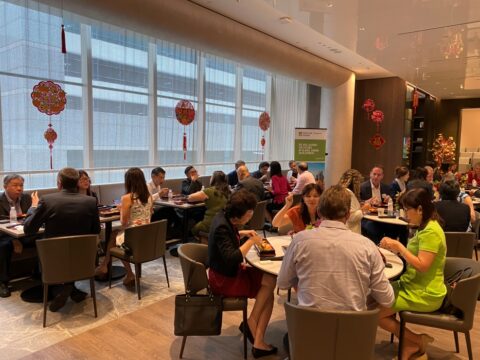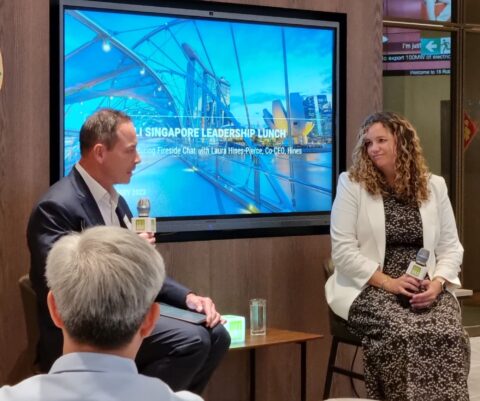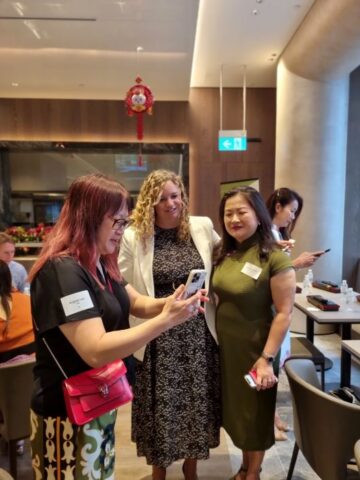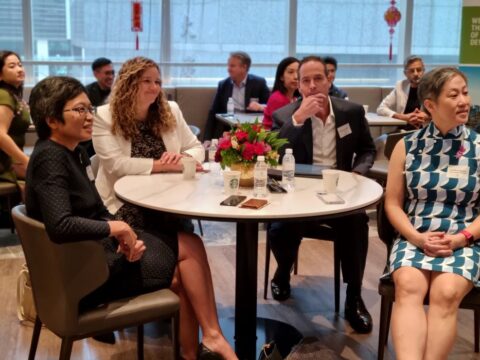Top Story
In Conversation with WLI Singapore Champion of Change Adeline Ong, SVP, Frasers Property Limited
One of ULI's young members Valerie Chua sits down with Adeline Ong, SVP of Frasers Property Limited to speak about her pledge commitments.
16 February 2023
Nicole Lum, Centre for Liveable Cities | YLG Committee Member
Over an exclusive fireside chat facilitated by ULI Singapore Executive Committee member Anthony Couse, CEO of JLL Asia Pacific, invited ULI leaders and supporters had the privilege to openly converse about issues close to their hearts with the amiable co-CEO of Hines, Laura Hines-Pierce. The event that took place on 31 January 2023 marked the end of Laura’s month in Singapore as part of her six-month-long global tour. ULI Singapore Young Leaders Group (YLG) Committee member Nicole Lum captures the details.

Exclusive opportunity for invited ULI Singapore members to connect over lunch and engage with Laura Hines-Pierce, co-CEO, Hines
During her time in APAC, the region showed promise and potential in real estate
While the last few months have been challenging for new mum Laura – who produced two babies during the pandemic (and so did Anthony!) – being able to spend time with her teams and partners was rewarding as she got to deeply understand various markets and their exciting opportunities. Unique to Singapore was the thoughtfulness of planning that went into the thinking, focused greatly on design, which led to better value and integration with the community. Hines saw new potential in the small island city-state and grew exponentially from ground zero in 2019, to about 30 team members four years later. Regionally, two more offices were slated to open, to establish more boots on the ground, build relationships and find opportunities.
Some of these opportunities included: exploring different residential approaches like co-living, and introducing built-to-rent in Australia and rental housing in Japan and Korea; leveraging the new ways industrial space was being used such as cold storage in Japan; and reimagining the role and design of the office.
Many ULI members agreed with Laura as the huge growth in income meant enormous rise in demand for real estate in APAC. Developing areas lacking deep experience may even embrace a process change, wherein global developers could partner with locals to bring something unforeseen.
As for China which was an existing market, Hines would continue to deepen their expertise and take a long-term view – a benefit of the family business, unlike other firms that get buoyed by rapidly changing viewpoints.

ULI Singapore Executive Committee member Anthony Couse, JLL poses a question to Laura Hines-Pierce, co-CEO, Hines
The role of the physical workplace was changing but remained important
Also rapidly changing was the future of work. Laura felt that the pandemic did not create a massive revolution, but rather sped up the trends of what office meant to people. True flight-to-quality was creating reasons for people to return to the office – some functions (e.g. more heads-down, individualistic work) could operate remotely and help to cut cost, while companies that required cross-functional innovations have realised the need to upgrade their workplaces to draw people back.
Within the tech sector, real estate had been cut to help manage cost. But Laura surmised that this approach would backfire to a degree, when high-touch, innovative tech support returned to the office and an equilibrium over time. With the right tools and workspace, people would be motivated to work and build their career in person.
What real estate meant to people was changing. Thus, Hines focused not just on providing the physical asset but the experience to its tenants.
However, with the multitude of trends at play, Laura felt that it was hard to determine what was going to hit. Staying resilient and flexible, keeping an eye on potential challenges and being aware of the blind spots would help Hines navigate them well.
Leadership within the firm and the industry must be cultivated purposefully with a long-term view
As the third generation of the family business that was started 65 years ago by her grandfather, Laura felt fortunate to be a part of it with her dad as co-CEO, who had led and navigated Hines through its formative years. Laura was thus able to contribute her strengths at a phase wherein she could think about its next 30 years and positioning it for the challenges to come. Real estate was a long-term business and investing for the future was key.
Of course, sustainability was a big part of her aspirations, although there was no obvious path to it. She knew that leadership, innovation, investment and commitment across the industry was required to put in place the enabling infrastructure. However, as every asset and geography were different, they would need differing methodologies, and no one cure-all solution existed. The hope was that the difficult step-by-step work would build capabilities and learning over time.
In addition to operational carbon, Hines also desired to lead on embodied carbon, which was an even harder goal to achieve. To start, the company put out an embodied carbon guide that encouraged stakeholders to ask questions during development processes and make sustainable choices without cost differences.
“It is about how we give our leaders support and autonomy and creating the infrastructure to keep them around for a long time, build trust and align ourselves”.
Laura Hines-Pierce, co-CEO, Hines
When asked about the firm’s next generation, Laura said that Hines had been thoughtful about the transition, putting in place the right infrastructure and guardrails for its leadership. But besides ensuring the right leadership in the family, Laura stressed that it was much more critical to ensure the right leadership across the firm. “It is about how we give our leaders support and autonomy,” she shared, “and creating the infrastructure to keep them around for a long time, build trust and align ourselves”.
The culture at Hines had been one of their secret sauces for a long time. Historically, their growth was always organic and purposeful, and never through merger and acquisition. They focused on nurturing a consensus-driven environment and sense of ownership, allowing their staff to feel confident whenever they gave and received feedback. Importantly, Hines ensured that they did not have any family members in leadership positions besides the CEO office.
Establishing holistic support systems and processes that celebrated diversity were some of the co-CEO’s priorities for Hines
Laura also reflected on her learning process as she juggled babies and business over the past few years. She had moved into her current role two months before her daughter was born and was purposeful about taking full leave after. Not only because she needed it, but also because she wanted to make sure that the firm understood that it was possible to integrate different aspects of life – to be in a demanding role and still take the time to be with family. Role modelling, to her, was important. She wanted to create more visibility around this topic and encourage creating the right support system and work environment for not just women, but all parents and caregivers. “The more we focus on helping women, the more it creates the idea of ‘other’,” she explained.
As Hines’ Transformation Officer between 2018 and 2020, Laura introduced several DEI (diversity, equity and inclusion) initiatives ranging from support policies around work benefits to Employee Resource Groups that aimed to connect the firm across several diversity matrices. As far as DEI, Hines also spent time to figure out how goals were being set. Rather than setting goals around percentages, they had found that setting goals around process was more important – one that was designed to support diversity as people moved through their careers to nurture the best people for the role.
Rounding up the discussion, Laura shared some advice to the men in the room: “Part of the historical challenge women face is that there is an expectation to do two full time jobs, at work and at home. The more there is a shared expectation for men to also take responsibility and ownership at home, the less there is an inequality across the board,” she said.

Meeting Laura Hines-Pierce in person

Laura shares openly about her views of Asia Pacific, the firm’s ambitions for net zero, and their continuous efforts to drive DEI.

ULI Singapore leaders and supporters re-connected over lunch before the fireside chat.

ULI Singapore leaders and supporters re-connected over lunch before the fireside chat.

ULI Singapore leaders and supporters re-connected over lunch before the fireside chat.

The members enjoyed a friendly dialogue with Laura.

ULI is its members

Taking interesting questions from the floor.

Laura also had the opportunity to throw back a question or two.

(L-R) Ng Chiang Ling, Laura Hines-Pierce, Anthony Couse, Hwang Yu-Ning

Connecting in person

Settling down for lunch
Don’t have an account? Sign up for a ULI guest account.

Meeting Laura Hines-Pierce in person

Laura shares openly about her views of Asia Pacific, the firm’s ambitions for net zero, and their continuous efforts to drive DEI.

ULI Singapore leaders and supporters re-connected over lunch before the fireside chat.

ULI Singapore leaders and supporters re-connected over lunch before the fireside chat.

ULI Singapore leaders and supporters re-connected over lunch before the fireside chat.

The members enjoyed a friendly dialogue with Laura.

ULI is its members

Taking interesting questions from the floor.

Laura also had the opportunity to throw back a question or two.

(L-R) Ng Chiang Ling, Laura Hines-Pierce, Anthony Couse, Hwang Yu-Ning

Connecting in person

Settling down for lunch